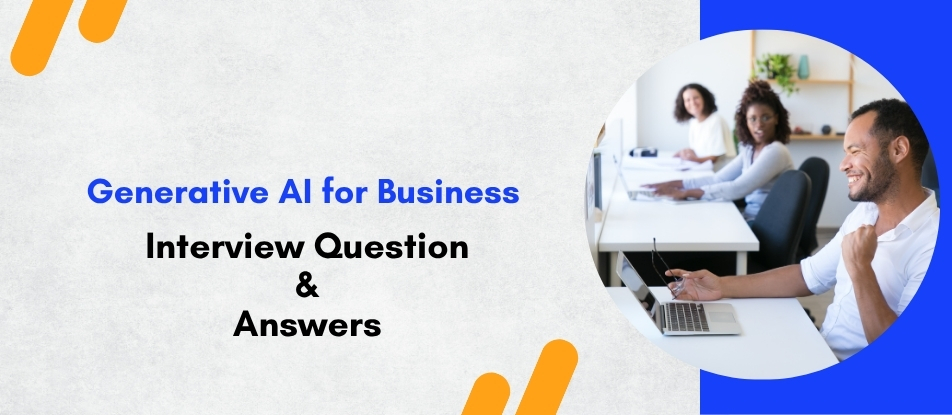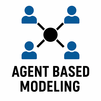
The Generative AI for Business course provides professionals with practical knowledge to harness AI-driven tools for content generation, customer engagement, product innovation, and process automation. Covering advanced applications like prompt engineering, AI integration with CRMs and ERPs, and responsible AI usage, this course prepares learners to strategically implement Generative AI solutions that boost productivity, personalization, and scalability in various business environments across industries.
Generative AI for Business Training Interview Questions Answers - For Intermediate
1. How can Generative AI streamline internal business operations?
Generative AI can automate repetitive and time-consuming tasks like drafting emails, summarizing meeting notes, creating internal reports, and generating standard documentation. This allows employees to focus on higher-value strategic work. It also supports HR with job descriptions, onboarding material, and policy documentation, thereby increasing productivity and reducing turnaround times across departments.
2. In what ways is Generative AI transforming the e-commerce industry?
In e-commerce, Generative AI creates product descriptions, personalized recommendations, customer chat support, and targeted ad copy. It enables A/B testing at scale by quickly generating variations of product titles or marketing messages. It also helps generate visuals, voiceovers, and video demos to enhance product listings, ultimately improving conversion rates and customer retention.
3. How does Generative AI assist in business intelligence and reporting?
Generative AI can summarize complex datasets, write executive summaries, and translate technical analytics into plain language. It automates the creation of business reports and dashboards by transforming raw data into coherent insights. This makes business intelligence more accessible to non-technical stakeholders and accelerates decision-making across all levels of the organization.
4. What are the risks of using Generative AI in regulated industries?
In regulated industries like finance, healthcare, or law, Generative AI poses risks including generating inaccurate, misleading, or non-compliant content. If not properly validated, outputs may violate legal, ethical, or data protection regulations. Therefore, rigorous oversight, human review, and governance frameworks are essential before deploying AI tools in these environments.
5. How can Generative AI support sales and lead generation?
Generative AI can write tailored outreach emails, create sales pitches, and summarize customer profiles. It can also score leads based on engagement and generate follow-up suggestions. Sales teams benefit from AI-generated scripts, call summaries, and competitor comparisons, allowing them to personalize interactions and close deals more effectively.
6. What is retrieval-augmented generation (RAG), and how is it used in business?
RAG combines the strengths of information retrieval and generative models. It fetches relevant documents or data from a knowledge base and uses a language model to generate informed responses. In business, it’s used in customer support, internal knowledge management, and legal document drafting where accuracy and context from real-time data are critical.
7. How can Generative AI help in employee training and onboarding?
Generative AI can create personalized training materials, quizzes, onboarding guides, and learning simulations tailored to roles and departments. It can answer employee questions in real time through AI assistants and reduce the burden on HR and L&D teams. This leads to faster onboarding, higher engagement, and more effective knowledge transfer.
8. What role does Generative AI play in competitive intelligence?
Generative AI can monitor competitors' content, analyze pricing trends, summarize reviews, and generate comparative reports. It helps synthesize publicly available information into actionable insights, allowing businesses to adjust strategy, pricing, or messaging in response to market movements. This enables faster competitive analysis and more informed business planning.
9. How does Generative AI enhance brand voice and consistency?
By training or fine-tuning models on a company’s existing content and communication guidelines, Generative AI can produce brand-consistent messages across multiple channels. This includes emails, blogs, social media, and customer support. It ensures tone, terminology, and style are consistent, which helps reinforce brand identity and credibility.
10. How does Generative AI contribute to digital transformation initiatives?
Generative AI accelerates digital transformation by automating knowledge work, enabling intelligent automation, and supporting real-time decision-making. It integrates with enterprise tools to streamline workflows, improve data accessibility, and reduce operational bottlenecks. Its ability to scale content, code, and insights enhances agility and supports innovation across the business landscape.
11. Can Generative AI be used for legal document drafting?
Yes, Generative AI can draft contracts, NDAs, legal summaries, and compliance documents based on templates and predefined clauses. It speeds up document generation, reduces manual effort, and ensures consistency. However, legal review is essential to validate accuracy, context relevance, and jurisdiction-specific requirements before use in official proceedings.
12. What is fine-tuning in the context of Generative AI for business?
Fine-tuning involves training a pre-existing generative model on domain-specific or proprietary data. In business, this enables the model to generate more accurate and relevant outputs aligned with organizational goals, terminology, and context. Fine-tuning ensures better control over content quality, compliance, and brand-specific language, making it ideal for enterprise applications.
13. How does Generative AI help in managing knowledge within organizations?
Generative AI can summarize documents, transcribe meetings, and answer employee questions using internal knowledge bases. It enables smart search and contextual content generation across intranets or shared repositories. This improves knowledge accessibility, supports cross-functional collaboration, and reduces the time spent searching for critical information.
14. What industries are early adopters of Generative AI and why?
Industries like marketing, software development, media, e-commerce, and customer support have adopted Generative AI early due to their content-heavy or customer-facing nature. These sectors benefit from AI’s ability to scale personalization, automate repetitive tasks, and reduce content production costs while increasing efficiency and engagement.
15. How can businesses prepare their workforce for Generative AI adoption?
Businesses can prepare by investing in employee training on AI literacy, change management, and prompt engineering. Establishing clear AI policies, involving teams in pilot programs, and promoting a culture of innovation helps ease the transition. Providing tools and support empowers employees to co-create with AI, enhancing productivity rather than fearing job loss.
Generative AI for Business Training Interview Questions Answers - For Advanced
1. How can enterprises ensure data privacy when using Generative AI tools that interact with customer or proprietary data?
Ensuring data privacy with Generative AI requires a layered approach. First, enterprises should anonymize or pseudonymize sensitive customer data before it is fed into AI models. Implementing strict access controls and encryption during data transmission and storage is essential. When using third-party APIs, organizations must review the vendor’s data usage policies to confirm that inputs and outputs are not stored or used for training. In high-risk sectors, deploying models on private clouds or on-premises can further reduce exposure. Additionally, integrating AI with data classification systems ensures that confidential information is not inadvertently processed or disclosed. Regular audits, privacy impact assessments, and compliance with standards like GDPR, CCPA, or HIPAA are necessary to maintain trust and legal compliance.
2. What role does multi-modal Generative AI play in enterprise innovation, and how can it be deployed effectively?
Multi-modal Generative AI combines inputs and outputs across different content types—text, images, audio, and video—enabling more immersive and interactive business applications. For example, in product design, it can generate 3D renderings from textual prompts, while in customer engagement, it can create personalized video messages with voiceovers. Enterprises deploy it for dynamic content generation, training simulations, or interactive marketing experiences. Effective deployment requires well-curated multi-format datasets, robust compute infrastructure (including GPUs and TPUs), and content validation pipelines. Integration with existing digital asset management systems ensures generated content adheres to brand and compliance standards. However, it demands cross-functional collaboration between marketing, IT, legal, and design teams to realize its full potential.
3. How should businesses evaluate the performance of Generative AI tools in practical deployments?
Performance evaluation of Generative AI tools involves both quantitative and qualitative metrics. Accuracy and relevance of outputs, latency, hallucination rate, and prompt-to-response quality are key metrics. Business KPIs like productivity gain, content delivery time, customer engagement, and ROI should also be assessed. Human-in-the-loop evaluation remains critical—especially in contexts like legal drafting, customer service, or compliance content—to verify tone, correctness, and alignment with brand guidelines. A/B testing can measure effectiveness across different user groups. Long-term tracking of system drift, update performance, and user satisfaction helps refine and maintain performance over time.
4. How does Generative AI support sustainable business practices and ESG initiatives?
Generative AI supports sustainability and ESG efforts by optimizing operations, reducing waste, and enhancing transparency. It can simulate supply chain scenarios to identify emission-reducing alternatives or generate sustainability reports aligned with ESG frameworks. In fashion and manufacturing, it can design eco-friendly product prototypes and packaging solutions. It can also aid in green marketing by producing educational content about sustainable practices. However, the carbon footprint of large models must be considered—organizations can mitigate this by using energy-efficient models, leveraging low-carbon cloud regions, and minimizing inference loads where possible.
5. What challenges arise in aligning Generative AI outputs with organizational tone and compliance, and how can they be addressed?
Generative AI may produce outputs that are technically correct but misaligned with a company's voice, tone, or compliance requirements. This is particularly problematic in customer-facing content or regulated documentation. Challenges include inconsistency in tone, unintentional bias, or the generation of unsupported claims. Addressing this requires fine-tuning models on brand-approved datasets, implementing reinforcement learning from human feedback (RLHF), and using prompt templates that embed style and compliance rules. Post-generation filters and approval workflows further reduce risks. Maintaining a central content governance framework ensures outputs remain on-brand and within regulatory guidelines across departments.
6. What is synthetic data generation using Generative AI, and how is it used in enterprise AI strategies?
Synthetic data generation uses Generative AI models—such as GANs or diffusion models—to create realistic yet artificial datasets that simulate real-world data. This is particularly useful when real data is scarce, expensive, or sensitive (e.g., in healthcare or finance). Enterprises use synthetic data to augment training datasets, test AI models in edge-case scenarios, or anonymize customer data while preserving statistical properties. It supports more inclusive and robust AI models by covering rare events. However, validating the fidelity and fairness of synthetic data is critical to ensure its usefulness without introducing artifacts or bias.
7. How can Generative AI be leveraged in human resources and talent acquisition?
Generative AI automates several HR functions, including drafting job descriptions, screening resumes, generating interview questions, and composing personalized candidate communications. In talent development, it helps design tailored learning paths, create onboarding material, and simulate workplace scenarios for training. For recruitment marketing, AI-generated video or content can improve employer branding. Care must be taken to avoid bias, especially in resume screening or candidate scoring—these systems must be monitored and audited regularly to ensure fairness, legality, and alignment with organizational DEI (Diversity, Equity, Inclusion) values.
8. How does Generative AI enable hyper-personalization in B2B marketing and customer success?
Generative AI enables hyper-personalization by dynamically generating content tailored to individual buyer personas, behaviors, or preferences. In B2B marketing, it can create custom sales decks, proposal templates, case studies, and product recommendations based on firmographic and behavioral data. For customer success, it drafts personalized onboarding guides, usage insights, and renewal reminders. The key is integrating AI with CRM and intent data platforms to ensure context accuracy. Guardrails must be established to prevent over-personalization, which may come off as intrusive or artificial.
9. How can CIOs and CTOs plan for secure, scalable Generative AI deployments in enterprise ecosystems?
CIOs and CTOs must adopt a strategic approach that balances innovation with risk management. This includes selecting cloud or on-prem deployments based on data sensitivity, establishing model lifecycle management processes, and ensuring compatibility with DevOps/ML Ops pipelines. Role-based access, API security, prompt usage monitoring, and output validation layers are critical to prevent misuse. Scalability can be achieved by containerizing models, using Kubernetes, and employing distributed inference setups. Additionally, policies on data retention, auditing, and incident response must be codified to protect enterprise integrity.
10. How does the integration of Generative AI with ERP and CRM systems benefit enterprise operations?
Integrating Generative AI with ERP and CRM systems allows businesses to generate intelligent insights, automated reports, and personalized communication at scale. In ERP, it assists in drafting inventory summaries, procurement requests, and vendor follow-ups. In CRM, it crafts personalized emails, generates meeting summaries, and provides intelligent sales nudges. This integration improves operational agility, shortens customer response time, and enhances relationship management. Middleware solutions, secure APIs, and prompt management tools ensure seamless and secure communication between the AI model and business platforms.
11. How can organizations handle hallucinations and inaccuracies in Generative AI outputs at scale?
Handling hallucinations—fabricated or incorrect outputs—requires proactive architecture. Techniques include grounding models with retrieval-augmented generation (RAG), prompt chaining, and using fine-tuned domain-specific models. Content moderation pipelines should include post-processing validation layers using traditional rule-based checks or fact-verification services. Human reviewers must be part of workflows for sensitive outputs. At scale, enterprises must log all prompts and responses, flag anomalies, and set thresholds for confidence levels before triggering automation actions, especially in mission-critical applications.
12. What is the role of Generative AI in driving product innovation and lifecycle management?
Generative AI supports product innovation by ideating new features, simulating customer feedback, and generating prototype designs. It can summarize product reviews to inform roadmap decisions or create user stories for development teams. In lifecycle management, it generates release notes, support documentation, and training content. AI also enables predictive modeling by simulating product performance under various conditions. When embedded into product management tools, it accelerates iteration cycles and improves cross-functional communication, leading to more agile, customer-centric development processes.
13. How can legal and compliance teams collaborate with AI teams to monitor Generative AI deployment?
Legal and compliance teams must be involved early in the AI development lifecycle. This includes reviewing training data sources, setting redlines for acceptable use, and co-developing content review checklists. Joint governance committees can oversee risk assessments, track emerging regulations (e.g., EU AI Act), and audit content logs for potential violations. Compliance teams also help define disclosure requirements—such as marking AI-generated content—and train employees on responsible usage. This collaborative approach ensures the technology evolves within legal and ethical boundaries.
14. What is the impact of open-source versus proprietary Generative AI models in enterprise use?
Open-source models like LLaMA, Mistral, or Falcon offer customization, transparency, and cost advantages, especially when deployed on-prem for sensitive data scenarios. They allow businesses to fine-tune models and enforce strict data privacy. However, they require more in-house expertise and infrastructure support. Proprietary models like GPT-4 or Claude offer cutting-edge performance, pre-built integrations, and enterprise-grade support but often come with higher costs and data-handling restrictions. Enterprises often adopt a hybrid approach—using proprietary APIs for general tasks and open-source models for domain-specific or secure applications.
15. How will the evolution of Generative AI agents influence business process automation in the next 3–5 years?
The rise of autonomous Generative AI agents—capable of performing multi-step tasks with minimal supervision—will dramatically advance business process automation. These agents will not just generate content, but also execute actions: querying databases, booking meetings, updating CRMs, and analyzing financial data. Over the next few years, they will evolve to collaborate, negotiate, and reason across departments, fundamentally reshaping workflows. Businesses will need to establish robust governance models, API orchestration layers, and human oversight mechanisms to manage these agents’ growing autonomy while ensuring accountability and alignment with strategic goals.
Course Schedule
| Jan, 2026 | Weekdays | Mon-Fri | Enquire Now |
| Weekend | Sat-Sun | Enquire Now | |
| Feb, 2026 | Weekdays | Mon-Fri | Enquire Now |
| Weekend | Sat-Sun | Enquire Now |
Related Courses
Related Articles
Related Interview
- MB-240 Microsoft Dynamics 365 for Field Service Associate Training Interview Questions Answers
- Automation Anywhere Solution Architect Training Interview Questions Answers
- SAP Master Data Governance on SAP S4 HANA Training Interview Questions Answers
- IDMC Administration Training Interview Questions Answers
- MB-800: Microsoft Dynamics 365 Business Central Functional Consultant Interview Questions
Related FAQ's
- Instructor-led Live Online Interactive Training
- Project Based Customized Learning
- Fast Track Training Program
- Self-paced learning
- In one-on-one training, you have the flexibility to choose the days, timings, and duration according to your preferences.
- We create a personalized training calendar based on your chosen schedule.
- Complete Live Online Interactive Training of the Course
- After Training Recorded Videos
- Session-wise Learning Material and notes for lifetime
- Practical & Assignments exercises
- Global Course Completion Certificate
- 24x7 after Training Support








 Join our Live Instructor-Led online classes delivered by industry experts
Join our Live Instructor-Led online classes delivered by industry experts